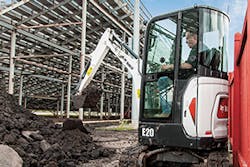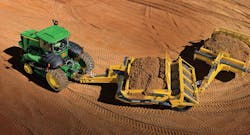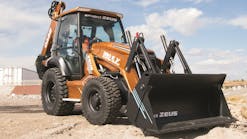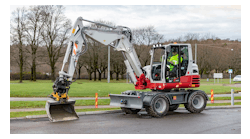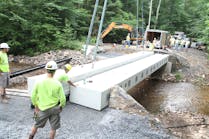There are limitations with compact equipment, of course, and an operator’s experience will surely play a role in whether to use one or to rely on something bigger. An operator is hardly going to open up an acre of land with a compact machine. Likewise, a contractor is probably not going to use anything where you need to lift above 12 feet, or lift something above a weight of 7,000 pounds, otherwise stability is sacrificed.
There are limitations with compact equipment, of course, and an operator’s experience will surely play a role in whether to use one or to rely on something bigger. An operator is hardly going to open up an acre of land with a compact machine. Likewise, a contractor is probably not going to use anything where you need to lift above 12 feet, or lift something above a weight of 7,000 pounds, otherwise stability is sacrificed. [text_ad] The limits of compact equipment can depend on how much, and where the material is being moved, as well as how tight the area is. It’s important to consider the physical size, rated operating capacity, and horsepower in terms of what needs to be accomplished. Tom Connor of Bobcat Equipment states that “grading and excavation contractors working in a new housing development may prefer to use compact equipment because of space constraints, especially if there are existing homes on either side of the home being built.” Even though a compact machine can’t move as much dirt as a bigger machine, it can move it more quickly. Still, it makes sense to use a bigger machine for a commercial project in most cases. A whole host of questions needs to be asked before deciding on a compact machine over something bigger. What is the type and density of the material being moved? How much material? Are there space restrictions? Gregg Warfel from Terex Construction Americas says, “The answers to these questions will help you determine the loader you need. Selecting the right loader is based on the amount of material (measured in cubic yards) that needs to be moved per hour, the weight of the material, and the area that the loader will operate in.” Other considerations are how quickly does the material need to be moved? Where is it going? One thing is for certain: compact equipment is working harder than ever. Every equipment owner knows that preventative maintenance is the key to keeping equipment running at maximum efficiency. During boom time, contractors usually hold on to their equipment for around three years. It’s typically bought, used, and discarded. Now the trend in many cases is to extend warranties out to five years, or 10,000 hours. The equipment is now more service friendly, so many business owners are taking the in-house approach and doing much of it themselves. Most tasks can be performed by anyone experienced in construction machinery, because compact equipment is easier to get to and more accessible. According to Vincent Whelan, vice president of product for JCB North America, “Dealers have adapted to do more of the repairs.” This boosts overall time on the job. Maintenance of compact equipment is the same as on their bigger counter parts, but doesn’t need to be performed as frequently as in the past. Whelan says JCB compact excavators have evolved and only have to be greased every 500 hours. Anderson makes the point that “it’s common to see 80, 90, or 100% utilization on these machines because they are so versatile. Many machines in these lower horsepower category are now Tier 4 Final, so there may be maintenance considerations related to that—but many manufacturers are working to make this as simple as possible.” Whelan mentions that CASE has focused much of its attention on maintenance-free or low maintenance emissions solutions to make the transitions smoother. There’s no question that each manufacturer is designing their fleet with more durable features such as debris management systems, better and more accessible cooling systems, heavy duty bumpers, and wenches for steep terrain. “We’re all pushing the envelope on how much we can fit in a small package and still get more performance,” says Jorge De Hoyos, a Kubota senior product manager. “Inevitably the laws of physics take over and more capacity in a small machine has its limits. And when capacity is needed, users need to go bigger.” Zupancic says that the largest John Deere skid-steer (332E) can move 185 metric tons per hour and their largest CTL (332E) moves 205 metric tons per hour. As a whole, the industry has made some incredible innovations that allow contractors to do more with less. Design innovations now allow for better visibility, more agility, more power, and better utilization rates, due to attachments. The question now becomes not so much “Why should a contractor use a piece of compact equipment?”, but “Why not?”The limits of compact equipment can depend on how much, and where the material is being moved, as well as how tight the area is. It’s important to consider the physical size, rated operating capacity, and horsepower in terms of what needs to be accomplished. Tom Connor of Bobcat Equipment states that “grading and excavation contractors working in a new housing development may prefer to use compact equipment because of space constraints, especially if there are existing homes on either side of the home being built.” Even though a compact machine can’t move as much dirt as a bigger machine, it can move it more quickly. Still, it makes sense to use a bigger machine for a commercial project in most cases.
A whole host of questions needs to be asked before deciding on a compact machine over something bigger. What is the type and density of the material being moved? How much material? Are there space restrictions? Gregg Warfel from Terex Construction Americas says, “The answers to these questions will help you determine the loader you need. Selecting the right loader is based on the amount of material (measured in cubic yards) that needs to be moved per hour, the weight of the material, and the area that the loader will operate in.” Other considerations are how quickly does the material need to be moved? Where is it going?
One thing is for certain: compact equipment is working harder than ever. Every equipment owner knows that preventative maintenance is the key to keeping equipment running at maximum efficiency. During boom time, contractors usually hold on to their equipment for around three years. It’s typically bought, used, and discarded. Now the trend in many cases is to extend warranties out to five years, or 10,000 hours. The equipment is now more service friendly, so many business owners are taking the in-house approach and doing much of it themselves. Most tasks can be performed by anyone experienced in construction machinery, because compact equipment is easier to get to and more accessible. According to Vincent Whelan, vice president of product for JCB North America, “Dealers have adapted to do more of the repairs.” This boosts overall time on the job. Maintenance of compact equipment is the same as on their bigger counter parts, but doesn’t need to be performed as frequently as in the past. Whelan says JCB compact excavators have evolved and only have to be greased every 500 hours. Anderson makes the point that “it’s common to see 80, 90, or 100% utilization on these machines because they are so versatile. Many machines in these lower horsepower category are now Tier 4 Final, so there may be maintenance considerations related to that—but many manufacturers are working to make this as simple as possible.”
Whelan mentions that CASE has focused much of its attention on maintenance-free or low maintenance emissions solutions to make the transitions smoother. There’s no question that each manufacturer is designing their fleet with more durable features such as debris management systems, better and more accessible cooling systems, heavy duty bumpers, and wenches for steep terrain.
“We’re all pushing the envelope on how much we can fit in a small package and still get more performance,” says Jorge De Hoyos, a Kubota senior product manager. “Inevitably the laws of physics take over and more capacity in a small machine has its limits. And when capacity is needed, users need to go bigger.” Zupancic says that the largest John Deere skid-steer (332E) can move 185 metric tons per hour and their largest CTL (332E) moves 205 metric tons per hour. As a whole, the industry has made some incredible innovations that allow contractors to do more with less. Design innovations now allow for better visibility, more agility, more power, and better utilization rates, due to attachments. The question now becomes not so much “Why should a contractor use a piece of compact equipment?”, but “Why not?”